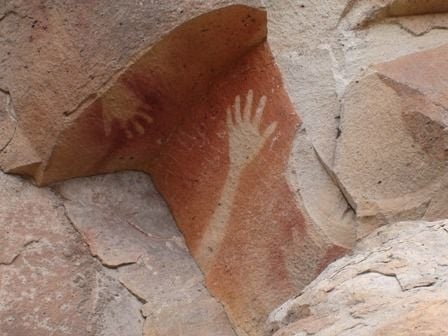The Case for Hand Stencils and Prints as Proprio-Performative
Abstract
:1. Introduction
2. The Hand’s Evolution
Man could not have attained his present dominant position in the world without the use of his hands, which are so admirably adapted to act in obedience to his will... But the hands and arms could hardly have become perfect enough to have manufactured weapons, or to have hurled stones and spears with a true aim, as long as they were habitually used for locomotion and for supporting the whole weight of the body...([12], p. 279)
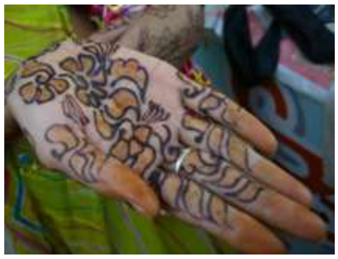
3. The Longevity of Hand Stencil- and Print-Making
4. Technique
The person puts a small handful of ochre or pipe-clay into his mouth and crunches it to a pulp; then he fills his mouth with water and thoroughly mixes the contents. He holds the hand he wishes to stencil against a flat surface, spacing the fingers at equal distances, and spurts the contents of his mouth all about it. A short while after, the hand is withdrawn. The area which it covered remains in its natural condition, whilst the space surrounding it has adopted the color of the ochre or clay.([41], p. 321)
5. Cultural Specificity

5.1. Placement
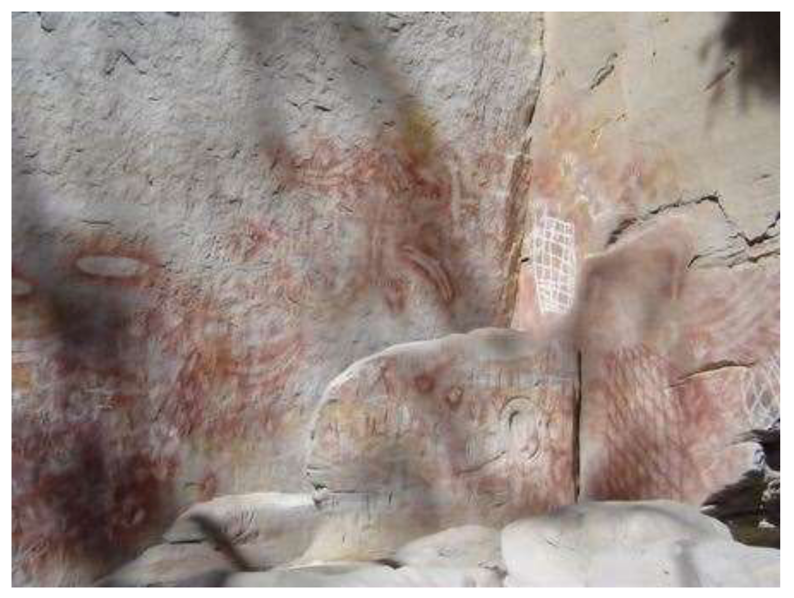
5.2. Size
5.3. Color
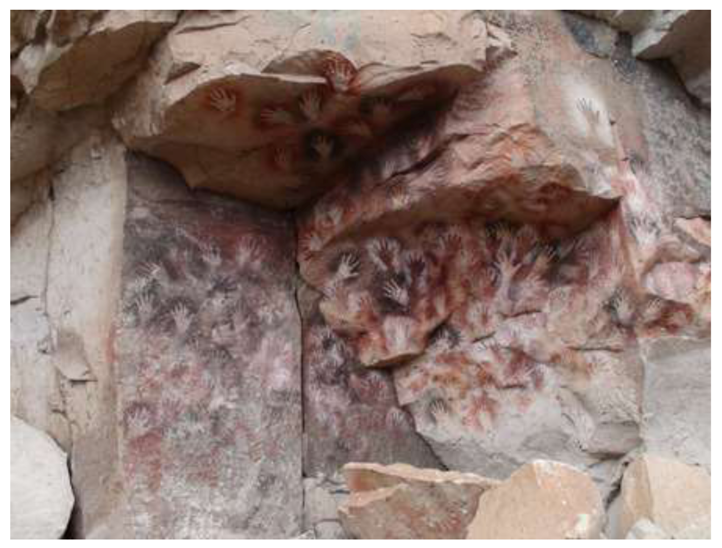
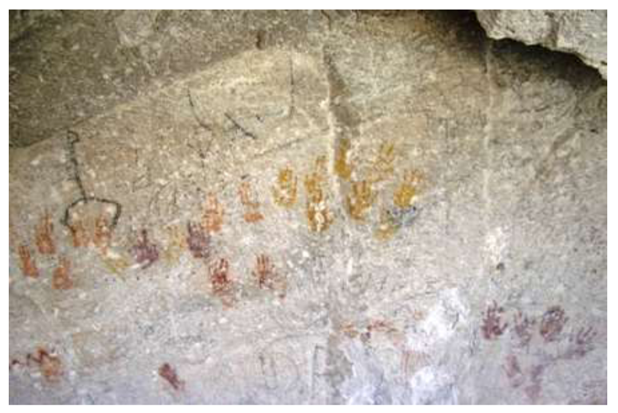
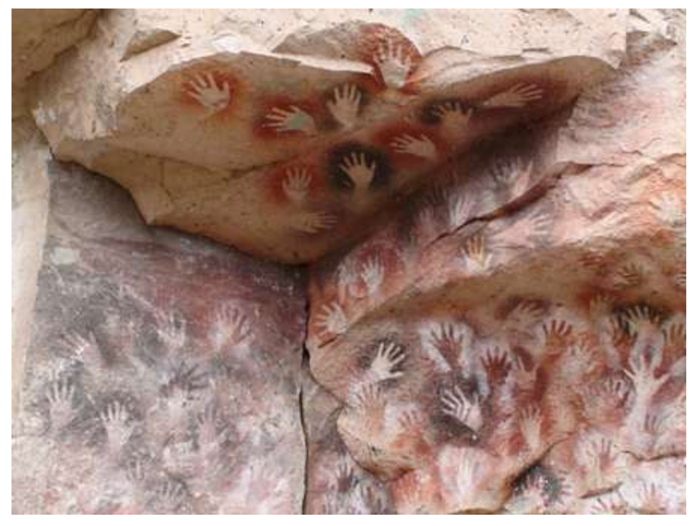

5.4. Decoration
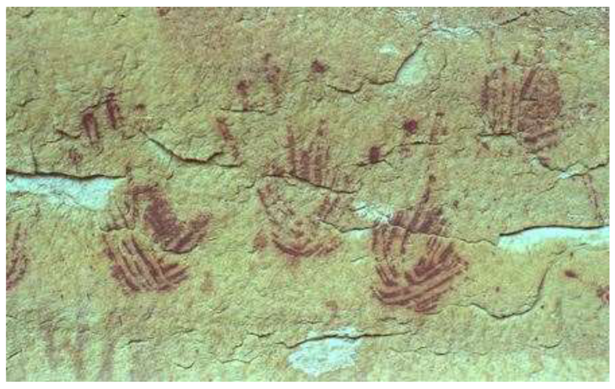
5.5. Digital Variations
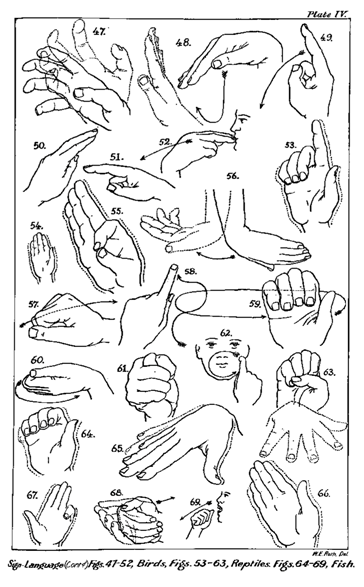
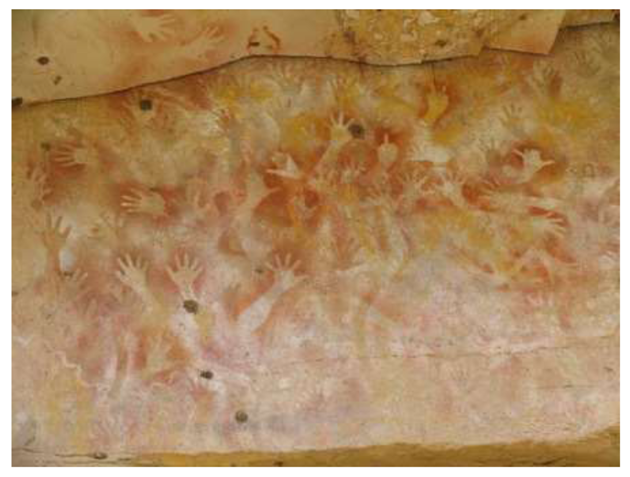
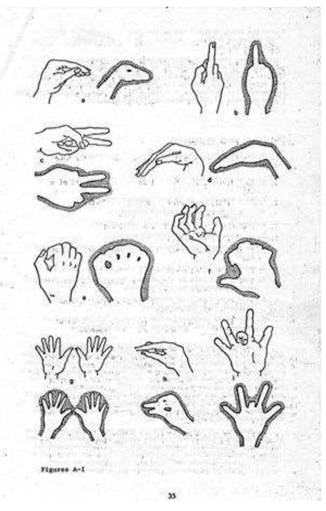
5.6. Choice of Right or Left Hand
In drawing the white hand, charcoal or red ochre is softened or moistened in the mouth and the clean bare hand pressed against the surface of some white or light colored rock, with the fingers of the hand well stretched out. The charcoal or ochre mixture is then blown or squirted against the back of the hand and well between the fingers and thumb and when the hand is withdrawn a perfect impression is left on the rock, enhanced by the dark surrounding of red or black as the case may be.([88], p. 272, italics mine)

5.7. Association with Other Motifs

The white stripes, which have puzzled most viewers, seem to be dangling from the arms like wing feathers. If my assumption is correct, then the boomerangs are obviously being thrown at this awe-inspiring figure by the stencilled hands.([97], p. 321)
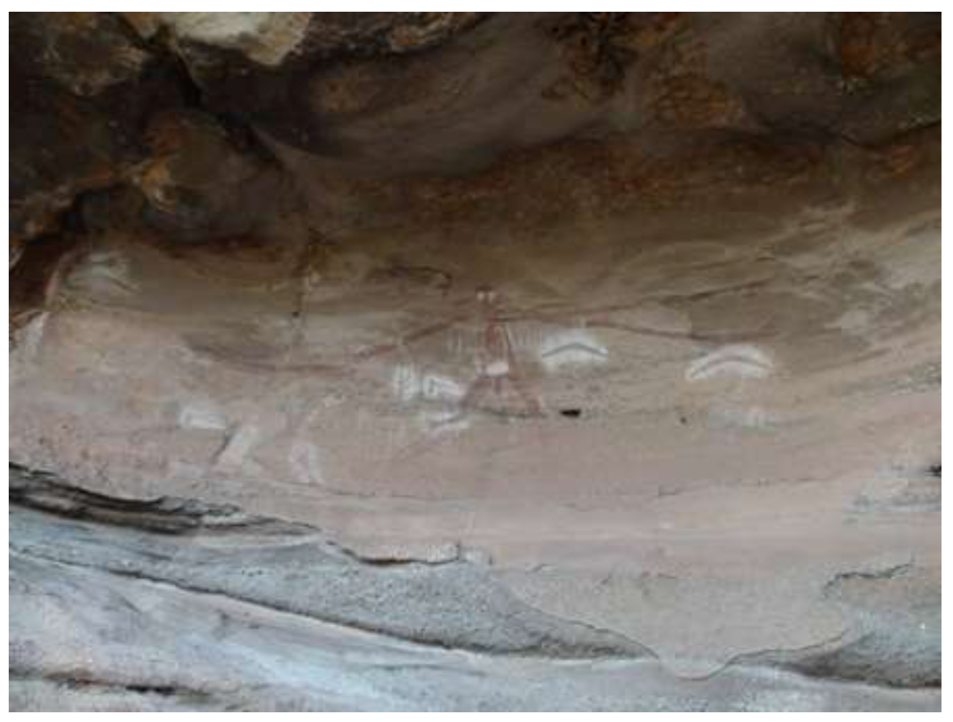


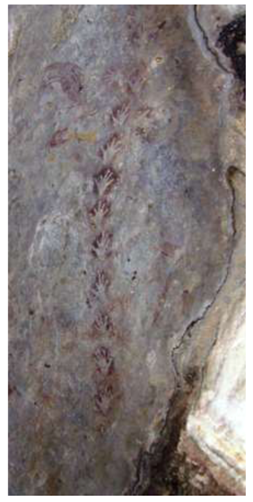
6. The Case for a Special Category

6.1. “Signatures”
It is the belief of a native of the north-west that the spirits of departed tribes-people desire to be revered by those nearest to them; and for that reason they keep a tally of their visits made to the sepulchral caves. By placing the imprint of his hand upon the wall, the native leaves evidence of his call... Each hand-mark can be recognized, not only by the person who made it but by every member of the tribe, with wonderful precision and reliability.
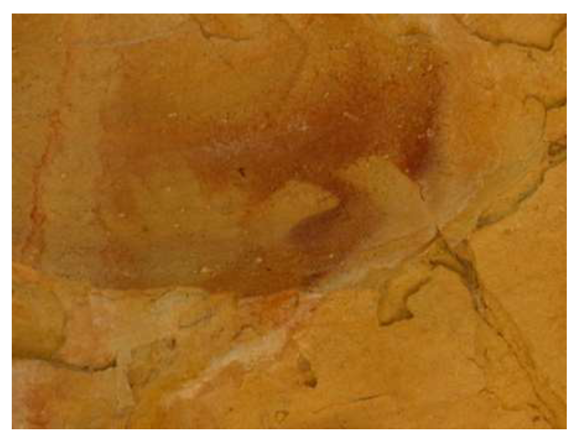
6.2. The “Ecological Self”
6.3. The Rock Surface as Rudimentary Mirror
6.4. Performative Images
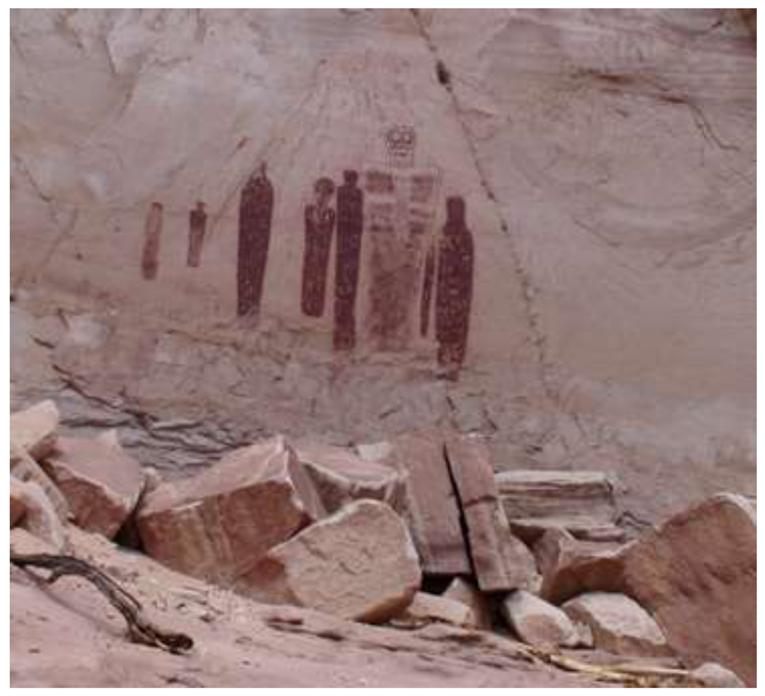
That what they’re telling usall that lot hand there... all that lot handhand is up there in that paintingthere saying stop!...Stop! Stop! don’t trespassStop! Listen to usAnd this is the hand sign saying stop([133], pp. 38–42; see also, p. 304)
6.5. The Looming Effect and Representational Momentum
6.6. Mirror Neurons
A necessary step for speech evolution was the transfer of gestural meaning, intrinsic to gesture itself, to abstract sound meaning. From this follows a clear neurophysiological prediction: Hand/arm and speech gestures must be strictly linked and must, at least in part, share a common neural substrate.([138], pp. 183–184)
7. What Qualifies as a Proprio-Performative?
7.1. Cultural Conditioning in Hand-Mark Reception
It represented a sea of or lake of fire, and out of that were stretched dusky brown arms, hundreds of them, in every conceivable position, some that almost spoke, the muscles knotted and the hands grasped convulsively; some pointing a weird skinny finger upwards, others clenched as though in the agonies of death.[143]
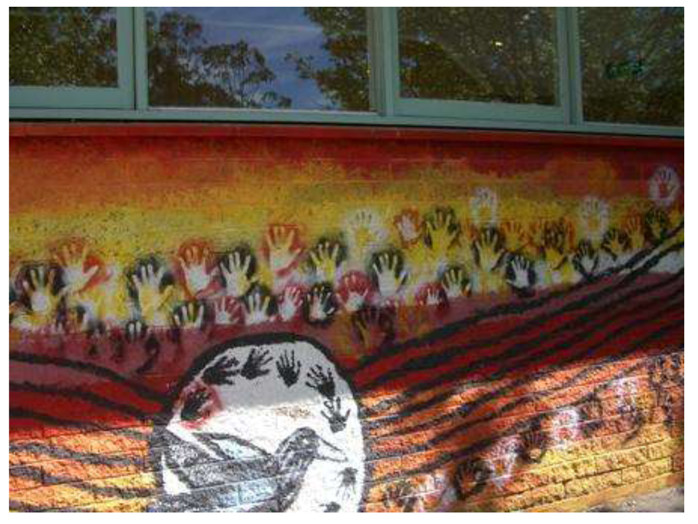
7.2. A Definition
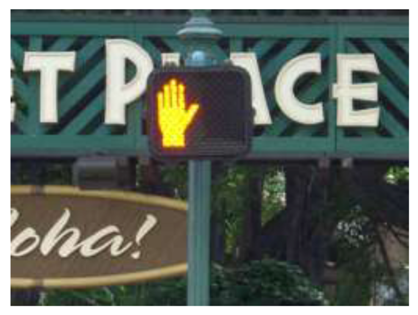
7.3. Exclusions
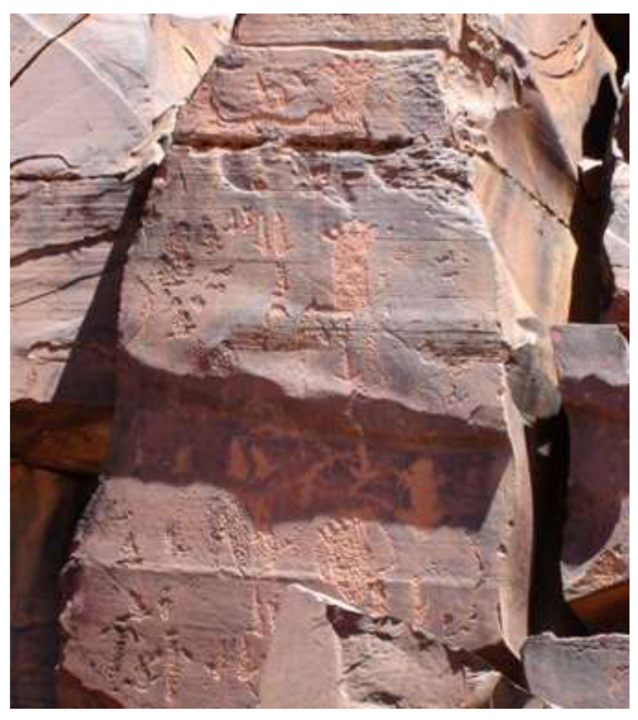
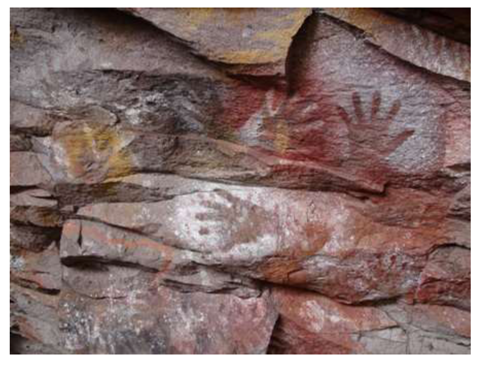

7.4. A Doubly Performative Proprio Image
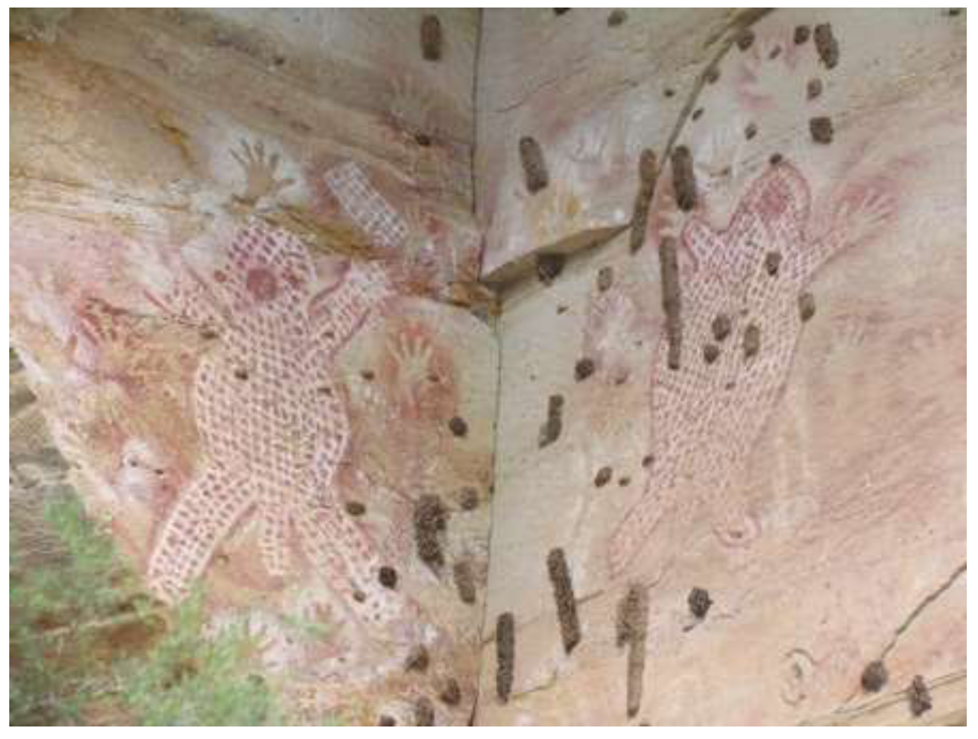
8. Conclusion
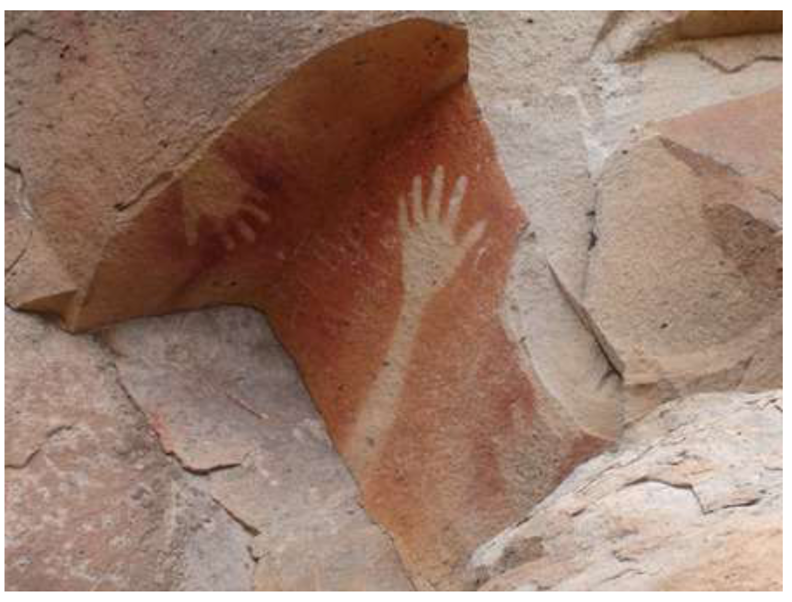
Acknowledgments
Conflicts of Interest
References
- J. Napier. Hands. revised by R.H. Tuttle; Princeton, NJ, USA: Princeton University Press, 1993. [Google Scholar]
- J.J. Gibson. The Senses Considered as Perceptual Systems. Boston, MA, USA: Houghton Mifflin, 1966. [Google Scholar]
- S.P. McPherron, Z. Alemseged, C. Marean, J.G. Wynn, D. Reed, D. Geraads, R. Bobe, and H. Béarat. “Evidence for stone-tool-assisted consumption of animal tissues before 3.39 million years ago at Dikka, Ethiopia.” Nature 466 (2010): 857–860. [Google Scholar] [CrossRef]
- S.P. McPherron, Z. Alemseged, C. Marean, J.G. Wynn, D. Reed, D. Geraads, R. Bobe, and H. Béarat. “Tool-marked bones from before the Oldowan change the paradigm.” Proc. Natl. Acad. Sci. USA 108 (2011): E116. [Google Scholar]
- M.W. Marzke, and M.S. Shackley. “Hominid hand use in the pliocene: Evidence from experimental archaeology and comparative morphology.” J. Hum. Evol. 15 (1986): 439–460. [Google Scholar] [CrossRef]
- S. Semaw, P. Renne, J.W.K. Harris, C.S. Feibel, R.L. Bernor, N. Fesseha, and K. Mowbray. “2.5 million-year-old stone tools from Gona, Ethiopia.” Nature 385 (1997): 333–336. [Google Scholar] [CrossRef]
- L.S.B. Leakey, P.V. Tobias, and J.R. Napier. “A new species of the genus Homo from Olduvai Gorge.” Nature 202 (1964): 7–9. [Google Scholar] [CrossRef]
- M.W. Marzke, and R.F. Marzke. “Evolution of the human hand: Approaches to acquiring, analysing and interpreting the anatomical evidence.” J. Anat. 197 (2000): 121–140. [Google Scholar]
- M. Donald. Origins of the Modern Mind: Three Stages in the Evolution of Culture and Cognition. Cambridge, MA, USA: Harvard University Press, 1993. [Google Scholar]
- L.A. Jones, and S.J. Lederman. Human hand Function. Oxford, UK: Oxford University Press, 2006. [Google Scholar]
- M.W. Tocheri, M.W. Marzke, D. Liu, M. Bae, G.P. Jones, R.C. Williams, and A. Razdan. “Functional capabilities of modern and fossil hominid hands: Three-dimensional analysis of trapezia.” Am. J. Phys. Anthropol. 122 (2003): 103–112. [Google Scholar]
- C. Darwin. “The Descent of Man.” In The Origin of Species by means of natural selection; The Descent of Man and selection in relation to sex. Chicago, IL, USA: William Benton and the University of Chicago, 1952, pp. 253–659. [Google Scholar]
- C. Rolian, D.E. Lieberman, and B. Hallgrimsson. “The coevolution of human hands and feet.” Evolution 64 (2010): 1558–1568. [Google Scholar] [CrossRef]
- T.L. Kivell, J.M. Kibil, S.E. Churchill, P. Schmid, and L.R. Berger. “Australopithecus sediba hand demonstrates mosaic evolution of locomotor and manipulative abilities.” Science 333 (2011): 1411–1417. [Google Scholar] [CrossRef]
- R. Peeters, L. Simone, K. Nelissen, M. Fabbri-Destro, W. Vanduffel, G. Rizzolatti, and G.A. Orban. “The representation of tool use in humans and monkeys: Common and uniquely human features.” J. Neurosci. 29 (2009): 11523–11539. [Google Scholar] [CrossRef]
- C.G. Gross, C.E. Rocha-Miranda, and D.B. Bender. “Visual properties of neurons in inferotemporal cortex of the macaque.” J. Neurophysiol. 35 (1972): 96–111. [Google Scholar]
- W. Penfield, and T. Rasmussen. The Cerebral Cortex of Man, A Clinical Study of Localization and Function. New York, NY, USA: The Macmillan Company, 1952. [Google Scholar]
- M.A. Arbib. “From monkey-like action recognition to human language: An evolutionary framework for neurolinguistics.” Behav. Brain Sci. 28 (2005): 105–124. [Google Scholar]
- G. Rizzolatti, L. Fogassi, and V. Gallese. “Neurophysiological mechanisms underlying the understanding and imitation of action.” Nat. Rev. Neurosci. 2 (2001): 661–670. [Google Scholar] [CrossRef]
- G. Rizzolatti, and A. Arbib. “Language within our grasp.” Trends Neurosci. 21 (1998): 188–194. [Google Scholar] [CrossRef]
- M. Lorblanchet. La Naissance de l’Art: Genèse de l’art préhistorique dans le monde. Paris, France: Ėditions Errance, 1999. [Google Scholar]
- J. Clottes, and J. Courtin. The Cave Beneath the Sea, Paleolithic Images at Cosquer. Translated by M. Garner. New York, NY, USA: Harry N. Abrams, 1996. [Google Scholar]
- A.W.G. Pike, D.L. Hoffmann, M. Garcia-Diez, P.B. Pettit, J. Alcolea, R. de Balbin, C. González-Sainz, C. de las Heras, J.A. Lasheras, R. Montes, and et al. “U-Series dating of paleolithic art in 11 Caves in Spain.” Science 336 (2012): 1409–1413. [Google Scholar] [CrossRef]
- R.G. Bednarik. “U-Th analysis and rock art: A response to Pike et al.” Rock Art Res. 29 (2012): 244–246. [Google Scholar]
- R. Layton. Australian Rock Art: A New Synthesis. Cambridge, UK: Cambridge University Press, 1992. [Google Scholar]
- K. Mulvaney. “What to do on a rainy day.” Rock Art Res. 13 (1996): 3–20. [Google Scholar]
- D.A. Roberts, and A. Parker. Ancient Ochres: The Aboriginal Rock Paintings of Mt Borradaile. Marleston, Australia: J.B. Books Australia, 2003. [Google Scholar]
- M. Dubey-Pathek, and J. Clottes. “Handprints in the Rock Art and Tribal Art of Central India.” In International Federation of Rock Art Organizations 2013 Proceedings ,American Indian Rock Art; Glendale, AZ, USA: ARARA, 2013, Volume 40, pp. 373–382. [Google Scholar]
- J.A. Efremov. “Taphonomy: New branch of paleontology.” Pan-Am. Geol. 74 (1940): 81–93. [Google Scholar]
- R.G. Bednarik. “A unified theory for palaeoart studies.” Rock Art Res. 23 (2006): 85–88. [Google Scholar]
- J. Clottes, ed. Return to Chauvet Cave: Excavating the Birthplace of Art: The First Full Report. London, UK: Thames and Hudson, 2003.
- R.G. Gunn, L.C. Douglas, and R.L. Whear. “An example of stencil masking from the Arnhem Land Plateau.” Rock Art Res. 29 (2012): 238–241. [Google Scholar]
- C. Barrière, and M. Sueres. “Les mains de Gargas.” Les Dossiers d’Archéologie 178 (1993): 46–55. [Google Scholar]
- H. Breuil. Four Hundred Centuries of Cave Art. Translated by M.E. Boyle. New York, NY, USA: Hacker Art Books, 1979. [Google Scholar]
- R.G. Bednarik, A. Achrati, M. Consens, F. Coimbra, G. Dimitriadis, T. Huisheng, A. Muzzolini, D. Seglie, and Y.A. Sher. Rock Art Glossary: A Multilingual Dictionary. Occasional AURA Publication 16; Melbourne, Australia: AURA, 2010. [Google Scholar]
- P.G. Bahn, and J. Vertut. Journey through the Ice Age. London, UK: Weidenfeld and Nicolson, 1997. [Google Scholar]
- J.D. Keyser, and M.A. Klassen. Plains Indian Rock Art. Seattle, WA, USA: University of Washington Press, 2001. [Google Scholar]
- C.J. Gradin, C.A. Aschero, and A.M. Aguerre. “Investigaciones Archeológicas en la Cueva de las Manos, Estancia Alto Rio pinturas (Provincia de Santa Cruz).” Relaciones da la Sociedad de Antropologia 10 (1976): 201–250. [Google Scholar]
- M.M. Podestá, R.S. Paunero, and D.S. Rolandi. El Arte Rupestre de Argentina Indigena, 1ª parte: Patagonia. Argentina: Unión Académique Internationale, 2005. [Google Scholar]
- F.D. McCarthy. Rock Art of the Cobar Pediplain in Central Western New South Wales. Canberra, Australia: Australian Institute of Aboriginal Studies, 1976. [Google Scholar]
- H. Basedow. The Australian Aboriginal. Adelaide, Australia: F. W. Preece & Sons, 1925. [Google Scholar]
- P. Tresize. Dream Road, a Journey of Discovery. St Leonards, Australia: Allen & Unwin, 1997. [Google Scholar]
- R.G. Gunn. “Hand sizes in rock art: Interpreting the measurements of hand stencils and prints.” Rock Art Res. 2 (2006): 97–112. [Google Scholar]
- M. Greer, and J. Greer. “Handprints in Montana rock art.” Plains Anthropol.: J. Plains Anthropol. Soc. 44 (1999): 59–71. [Google Scholar]
- S. Champion. The Dawn of European Art: An Introduction to Palaeolithic Cave Painting. S. Champion. Cambridge, UK: Cambridge University Press, 1982. [Google Scholar]
- S. Freers. “The hand prints at CA-RIV-114: A forensic and anthropometric study.” Am. Rock Art Res. 27 (2001): 319–332. [Google Scholar]
- R. Bednarik. “Children as Pleistocene artists.” Rock Art Res. 25 (2008): 173–182. [Google Scholar]
- J.-M. Chazine, and A. Noury. “Sexual determination of hand stencils on the main panel of the Gua Masri II cave (East –Kalimantan/Borneo – Indonesia).” Int. Newsl. Rock Art 44 (2006): 21–26. [Google Scholar]
- J.T. Manning, D. Scutt, J. Wilson, and D.I. Lewis-Jones. “The ratio of 2nd to 4th digit length: A predictor of sperm numbers and concentrations of testosterone, luteinising hormone and oestrogen.” Hum. Reprod. 13 (1998): 3000–3004. [Google Scholar] [CrossRef]
- D.R. Snow. “Sexual dimorphism in Upper Palaeolithic hand stencils.” Antiquity 80 (2006): 390–404. [Google Scholar]
- E.C. Nelson, J.T. Manning, and G.M. Sinclair. “Using the length of the 2nd to 4th digit ratio (2D/4D) to sex cave art hand stencils: Factors to consider.” Beyond Farming 1 (2006): 1–7. [Google Scholar]
- J. Brůžek, M. Lázničková, P. Galeta, and J. Maestracci. “Les empreintes de mains dans l’art parietal: Possibilités et limites d’interprétations mises en relief par l’anthropologie medico-légale.” In L’art pléistocène dans le monde; Actes de congrés IFRAO, Tarasocon-sur-Ariège, septembre 2010; N° spécial de Préhistoire. Edited by J. Clottes. Ariège, France: Bulletin de la Société Préhistorique Ariège-Pyrénées, 2010–2011, LXV-LXVI, pp. 1197–1206. [Google Scholar]
- S. Freers. “Stature and Gender Projections from Pictograph Handprint Evidence in Southern California. Unpublished paper presented in Session 7.” In Proceedings of Ancient Hands around the World, International Federation of Rock Art Organizations Congress, Albuquerque, NM, USA, 26–31 May 2013.
- J.-M. Chazine. “Some clues from Borneo for deciphering hand stencils.” In International Federation of Rock Art Organizations 2013 Proceedings ,American Indian Rock Art; Glendale, AZ, USA: ARARA, Volume 40, pp. 363–372.
- A. Robins, and A. Nowell. “Who Drew All Over the Wall? The Applicability of 2D/4D Ratio for Sexing Children’s Hand Stencils in Rock Art. Unpublished paper presented in Session 7.” In Proceedings of Ancient Hands Around the World, International Federation of Rock Art Organizations Congress, Albuquerque, NM, USA, 26–31 May 2013.
- P.B. Beaumont, and R.G. Bednarik. “A Brief Overview of Major Pleistocene Rock Art Sites in Sub-Sharan Africa.” In L’art pléistocène dans le monde; Actes de congrés IFRAO, Tarasocon-sur-Ariège, septembre 2010; N° spécial de Préhistoire. Edited by J. Clottes. Ariège, France: Bulletin de la Société Préhistorique Ariège-Pyrénées, 2010–2011, LXV-LXVI, pp. 541–548. [Google Scholar]
- P.B. Beaumont, and R.G. Bednarik. “Tracing the emergence of palaeoart in sub-Saharan Africa.” Rock Art Res. 30 (2013): 33–54. [Google Scholar]
- R.G. Bednarik. “The earliest evidence of palaeoart.” Rock Art Res. 20 (2003): 89–135. [Google Scholar]
- R.G. Bednarik. “A figurine from the African Acheulian.” Curr. Anthropol. 44 (2003): 405–413. [Google Scholar] [CrossRef]
- C.S. Henshilwood, F. d’Errico, K.L. van Niekerk, Y. Coquinot, Z. Jacobs, S.-E. Lauritzen, M. Menu, and R. García-Moreno. “A 100,000-year-old ochre-processing workshop at Blombos Cave, South Africa.” Science 334 (2011): 219–222. [Google Scholar] [CrossRef]
- G. Chaloupka. Journey in Time, the World’s Longest Continuing Art Tradition. Chatswood, Australia: William Heinemann Australia, 1993. [Google Scholar]
- S. Petru. “Red, black or white? The dawn of color symbolism.” Doc. Praehist. 33 (2006): 203–208. [Google Scholar]
- I.N.M. Wainright, K. Helwig, D.S. Rolandi, C. Gradin, M.M. Podestá, M. Onetto, and C.A. Achero. ICOM Committee for Conservation,13th Triennial Meeting, Rio de Janeiro, 22–27 September 2002. Edited by R. Vontobel. London, UK: James and James (Science Publishers), 2002, pp. 582–589.
- C.J. Gradin, A.M. Aguerre, and M.C. Mattar. Cueva de las Manos (Pamphlet). Perito Morena, Santa Cruz, Argentina: Hotel Belgrano, 2007. [Google Scholar]
- A. Leroi-Gourhan. “Les Mains de Gargas. Essai pour une étude d’ensemble.” Bulletin de la Société préhistorique française. Études et travaux 64 (1967): 107–122. [Google Scholar] [CrossRef]
- P.S.C. Taçon. “From Rainbow Snakes to ‘X-Ray’ Fish: The Nature of the Recent Rock Painting Tradition of Western Arnhem Land, Australia.” Ph.D. Unpublished Thesis, Australian National University, Canberra, Australia, 1989. [Google Scholar]
- A.P. Elkin. “Cave paintings in southern Arnhem Land.” Oceania 22 (1952): 245–255. [Google Scholar]
- R.G. Gunn. “Patterned hand prints: A unique form from Central Australia.” Rock Art Res. 15 (1998): 75–80. [Google Scholar]
- C. Grant. Canyon de Chelly: Its People and Rock Art. Tucson, AZ, USA: The University of Arizona Press, 1978. [Google Scholar]
- A. Manhire. “The role of hand prints in the rock art of the south-western Cape.” S. Afr. Archaeol. Bull. 53 (1998): 98–108. [Google Scholar] [CrossRef]
- W.J.J. Van Ryssen. “The origin of certain images in the rock art of southern Africa, and Comments.” Rock Art Res. 2 (1985): 146–157. [Google Scholar]
- E. Malotki, and D.E. Weaver Jr. Stone Chisel and Yucca Brush. Walnut, CA, USA: Kiva Publishing, 2002. [Google Scholar]
- P.G. Bahn. The Cambridge Illustrated History of Prehistoric Art. Cambridge, UK: Cambridge University Press, 1998. [Google Scholar]
- G.S. Breschini, and T. Haversat. The Esselen Indians of the Big Sur Country: The Land and the People. Salinas, CA, USA: Coyote Press, 2004. [Google Scholar]
- W. Tench. “A Narrative of the Expedition to Botany Bay.” In Sydney’s First Four Years; Fitzhardinge. Edited by L.F. Fitzhardinge. Sydney, Australia: Library of Australian History, 1979. [Google Scholar]
- D. Collins. An Account of the English Colony in New South Wales, Volume I. Edited by B.H. Fletcher. Sydney, Australia: A.H. & A.W. Reed, 1975. [Google Scholar]
- W.E. Roth. Ethnological Studies among the North-West-Central Queensland Aborigines. Brisbane, Australia: Government Printer, 1897. [Google Scholar]
- A.W. Howitt. The Native Tribes of South-East Australia. Edited by Facsimile. Canberra, Australia: Aboriginal Studies Press, 1996. [Google Scholar]
- A. Leroi-Gourhan. ; Translated by A. Michelson. “The hands of Gargas: Toward a general study.” October. 1986, 37, pp. 18–34. Available online: http://www.jstor.org/stable/778515 (accessed on 24 November 2012).
- G.L. Walsh. “Mutilated hands or signal stencils? A consideration of irregular hand stencils from central Queensland.” Aust. Archaeol. 9 (1979): 33–41. [Google Scholar]
- P. Tresize. Rock Art of South-East Cape York. Australian Institute of Aboriginal Studies No. 24, Prehistory and Material Culture Series No 4; Canberra, Australia: Australian Institute of Aboriginal Studies, 1971. [Google Scholar]
- B. Wright. “The significance of hand motif variations in the stenciled art of the Australian Aborigines, and Comments.” Rock Art Res. 2 (1985): 3–10. [Google Scholar]
- M. Groenen. “Les représentations de mains negatives dans les grottes de Gargas et de Tibaran (Hautes-Pyrénées): Approche méthodologique.” Bulletin Societé royale belge d’Anthropologie et de Préhistoire 99 (1988): 81–113. [Google Scholar]
- A. Hooper. “Further information on the prehistoric representations of human hands in the Cave of Gargas.” Med. Hist. 24 (1980): 214–216. [Google Scholar] [CrossRef]
- M.J. Morwood. Visions from the Past: The Archaeology of Aboriginal Art. Crows Nest, Australia: Allen & Unwin, 2002. [Google Scholar]
- W. Davis. “Commentary on Wright [82].” Rock art Res. 2 (1985): 17. [Google Scholar]
- J.-L. Le Quellec. “Can One “Read” Rock Art? An Egyptian Example.” In Iconography without Texts. Edited by P. Taylor. London, UK: Warburg Institute, 2008, pp. 25–42. [Google Scholar]
- D. Bates. The Native Tribes of Western Australia. Edited by I. White. Canberra, Australia: National Library of Australia, 1985. [Google Scholar]
- P.J. Ucko, and A. Rosenfeld. Palaeolithic Cave Art. London, UK: Weidenfeld & Nicolson, 1967. [Google Scholar]
- H. Basedow. Knights of the Boomerang. Sydney, Australia: The Endeavour Press, 1935. [Google Scholar]
- J. Flood. “Rock art of the Koolburra Plateau, north Queensland, with Comment.” Rock Art Res. 4 (1987): 91–126. [Google Scholar]
- L. Dobrez, and P. Dobrez. “Rock art animals in profile: Visual recognition and the principles of Canonical Form.” Rock Art Res. 30 (2013): 75–90. [Google Scholar]
- M. Tsakiris, S. Schütz-Bosbach, and S. Gallagher. “On agency and body-ownership: Phenomenological and neuroscience reflections.” Conscious. Cogn. 16 (2007): 645–660. [Google Scholar]
- M. Onetto, and M.M. Podestá. “Cueva de las Manos: An Outstanding Example of a Rock Art Site in South America.” In Adoranten 2011. Tanumshed, Sweden: Scandinavian Society for Prehistoric Art, Tanums Hällristningsmuseum Underslös, 2011, pp. 67–78. [Google Scholar]
- R.H. Mathews. “The rock paintings of the Australian Aborigines.” R. Geogr. Soc. Australas. Qld. Branch Proc. Trans. 11 (1896): 86–105. [Google Scholar]
- R.H. Mathews. “Rock paintings by the Aborigines in caves on Bulgar Creek, near Singleton.” J. R. Soc. N. S. W. 27 (1893): 353–358. [Google Scholar]
- D.R. Moore. “The Hand Stencil as Symbol.” In Form in Indigenous Art: Schematisation in the Art of Aboriginal Australia and Prehistoric Europe. Prehistory and Material Culture Series No. 13; Edited by P.J. Ucko. Canberra, Australia: Australian Institute of Aboriginal Studies, 1977, pp. 318–324. [Google Scholar]
- P. Elkin. Aboriginal Men of High Degree. St Lucia, Australia: University of Queensland Press, 1977. [Google Scholar]
- P. Mairet. Myths, Dreams and Mysteries. P. Mairet. London, UK: Fontana Library, 1968. [Google Scholar]
- N. Baker. Milbrodale Core Hole: Heritage due Diligence Study, Aboriginal and Historic Heritage. Report A12002RP1; Sydney, Australia: prepared for AGL Energy Ltd., 13 July 2012. [Google Scholar]
- P. Tresize. “Commentary on Wright [82].” Rock Art Res. 2 (1985): 16. [Google Scholar]
- P. Bouissac. “Probing prehistoric cultures: Data, dates and narratives.” Rock Art Res. 23 (2006): 89–96. [Google Scholar]
- A. Forge. “Handstencils: Rock Art or not Art.” In Rock Art and Prehistory: Papers Presented to Symposium G of the AURA Congress, Darwin 1988. Edited by P. Bahn and A. Rosenfeld. Oxford, UK: Oxbow Books, 1991, pp. 39–44. [Google Scholar]
- N. Peterson. “Totemism yesterday: Sentiment and local organization among the Australian Aborigines.” Man (new series) 7 (1972): 12–32. [Google Scholar]
- J. Flood. Rock Art of the Dreamtime. Sydney, Australia: Angus & Robertson, 1997. [Google Scholar]
- R. Layton. “The Alawa Totemic Landscape: Ecology, Religion and Politics.” In The Archaeology and Anthropology of Landscape, One World Archaeology 30. Edited by P.J. Ucko and R. Layton. London, UK: Routledge, 1999, pp. 221–241. [Google Scholar]
- E.J. Gibson. “Ontogenesis of the Perceived Self.” In The Perceived Self: Ecological and Interpersonal Sources of Self-Knowledge. Edited by U. Neisser. Cambridge, UK: Cambridge University Press, 1993, pp. 25–42. [Google Scholar]
- J.J. Gibson. The Ecological Approach to Visual Perception. Boston, MA, USA: Houghlin Mifflin, 1979. [Google Scholar]
- U. Neisser. “The Self Perceived.” In The Perceived Self:Ecological and Interpersonal Sources of Self-Knowledge. Edited by U. Neisser. Cambridge, UK: Cambridge University Press, 1993, pp. 3–21. [Google Scholar]
- S. Gallagher. “Philosophical conceptions of the self: Implications for cognitive science.” Trends Cogn. Sci. 4 (2000): 14–21. [Google Scholar] [CrossRef]
- S. Gallagher. How the Body Shapes the Mind. Oxford, UK: Clarendon Press, 2005, pp. 173–178. [Google Scholar]
- M. Tsakiris, P. Haggard, N. Franck, N. Mainy, and A. Sirigu. “A specific role for efferent information in self-recognition.” Cognition 96 (2005): 215–231. [Google Scholar] [CrossRef]
- L. Dobrez, and P. Dobrez. “Canonical form and the identification of rock art figures.” Am. Indian Rock Art 39 (2013): 114–129. [Google Scholar]
- G. Knoblich, I. Thornton, M. Grosjean, and M. Shiffrar. “Integrating Perspectives on Human Body Perception.” In Human Body Perception from the Inside Out. Edited by G. Knoblich , I. Thornton, M. Grosjean and M. Shiffrar. Oxford, UK: Oxford University Press, 2006, pp. 3–8. [Google Scholar]
- F.C. Shontz. “The Ecological Self in Historical Context.” In The Perceived Self: Ecological and Interpersonal Sources of Self-Knowledge. Edited by U. Neisser. Cambridge, UK: Cambridge University Press, 1993, pp. 89–101. [Google Scholar]
- J.L. Bermúdez. “Ecological Perception and the Notion of a Nonconceptual Point of View.” In The Body and the Self. Edited by J.L. Bermúdez, A. Marcel and N. Eilan. Cambridge, MA, USA: The MIT Press, 1998, pp. 153–173. [Google Scholar]
- D.N. Lee. “Body-Environment Coupling.” In The Perceived Self: Ecological and Interpersonal Sources of Self-Knowledge. Edited by U. Neisser. Cambridge, UK: Cambridge University Press, 1993, pp. 43–67. [Google Scholar]
- A. Kalckert, and H.H. Ehrsson. “Moving a rubber hand that feels like your own: A dissociation of ownership and agency.” Front. Hum. Neurosci. 6 (2012): 1–14. [Google Scholar]
- L.D. Walsh, G.L. Moseley, J.L. Taylor, and S.C. Gandevia. “Proprioceptive signals contribute to the sense of body ownership.” J. Physiol. 589 (2011): 3009–3021. [Google Scholar] [CrossRef]
- A. Maravita. “From “Body in the Brain” to “Body in Space”.” In Human Body Perception from the Inside Out. Edited by G. Knoblich , I. Thornton, M. Grosjean and M. Shiffrar. Oxford, UK: Oxford University Press, 2006, pp. 65–88. [Google Scholar]
- N.P. Holmes, and C. Spence. “Beyond the Body Schema: Visual, Prosthetic, and Technological Contributions to Bodily Perception and Awareness.” In Human Body Perception from the Inside Out. Edited by G. Knoblich , I. Thornton, M. Grosjean and M. Shiffrar. Oxford, UK: Oxford University Press, 2006, pp. 15–64. [Google Scholar]
- A. Rosenfeld. “Rock art and rock markings.” Aust. Archaeol. 49 (1999): 28–33. [Google Scholar]
- J. Clegg. “About pictures of echidnas and cats.” Rock Art Res. 12 (1995): 11–13. [Google Scholar]
- R.W. Mitchell. “Multiplicities of Self.” In Self-Awareness in Animals and Humans: Developmental Perspectives. Edited by S.T. Parker, R.W. Mitchell and M.L. Bocca. Cambridge, UK: Cambridge University Press, 1994, pp. 81–107. [Google Scholar]
- G.G. Gallup Jr. “Self-Recognition: Research Strategies and Experimental Design.” In Self-Awareness in Animals and Humans: Developmental Perspectives. Edited by S.T. Parker, R.W. Mitchell and M.L. Bocca. Cambridge, UK: Cambridge University Press, 1994, pp. 35–50. [Google Scholar]
- P. Rochat, and D. Zahavi. “The uncanny mirror: A re-framing of mirror self-experience.” Conscious. Cogn. 20 (2011): 204–213. [Google Scholar] [CrossRef]
- M. Merleau-Ponty. “The Child’s Relations with Others.” In The Primacy of Perception. Edited by M. Merleau-Ponty. Translated by W. Cobb. Evanston, IL, USA: Northwestern University Press, 1964, pp. 96–155. [Google Scholar]
- J.R. Anderson. “The Monkey in the Mirror: A Strange Conspecific.” In Self-Awareness in Animals and Humans: Developmental Perspectives. Edited by S.T. Parker, R.W. Mitchell and M.L. Bocca. Cambridge, UK: Cambridge University Press, 1994, pp. 315–329. [Google Scholar]
- J.J. Freyd, and R.R. Finke. “Representational Momentum.” J. Exp. Psychol. 10 (1984): 126–132. [Google Scholar]
- L. Dobrez. “American Ikon: How to choose an ARARA logo.” Am. Indian Rock Art 38 (2012): 145–164. [Google Scholar]
- L. Dobrez. “A Rock Art Typology: Narrative and Non-Narrative Figurative Representation.” In Aesthetics and Rock Art III Symposium. BAR International Series 1818; Edited by T. Heyd and J. Clegg. Oxford, UK: Archaeopress, 2008, pp. 29–33. [Google Scholar]
- L. Dobrez. “What representations tell us about what we see, with Commentary.” Purakala, Journal of Rock Art Society of India 20–21 (2010–2012): 23–41. [Google Scholar]
- Ngarjno, Ungudman, Banggal, and Nyawarra. Secret and Sacred Pathways of the Ngarinyin Aboriginal People of Australia. Edited by J. Doring. Köln, Germany: Könemann, 2000. [Google Scholar]
- C. Urgesi, V. Moro, M. Candidi, and S.M. Aglioti. “Mapping implied body actions in the human motor system.” J. Neurosci. 26 (2006): 7942–7949. [Google Scholar] [CrossRef]
- B. Watson. “The neuropsychology of animism and implied motion.” Rock Art Res. 27 (2010): 79–80. [Google Scholar]
- J.J. Freyd. “The mental representation of movement when static stimuli are viewed.” Percept. Psychophys. 33 (1983): 575–581. [Google Scholar] [CrossRef]
- M.H. Kelly, and J. Freyd. “Explorations of representational momentum.” Cogn. Psychol. 19 (1987): 369–401. [Google Scholar] [CrossRef]
- G. Rizzolatti, and L. Craighero. “The mirror-neuron system.” Annu. Rev. Neurosci. 27 (2004): 169–192. [Google Scholar] [CrossRef]
- C. Senior, J. Barnes, V. Giampietro, A. Simmons, E.T. Bullmore, M. Brammer, and A.S. David. “The functional neuroanatomy of implicit-motion perception or representational momentum.” Curr. Biol. 10 (2000): 16–22. [Google Scholar] [CrossRef]
- Z. Kourtzi, and N. Kanwisher. “Activation in human MT/MST by static images with implied motion.” J. Cogn. Neurosci. 12 (2000): 48–55. [Google Scholar] [CrossRef]
- A.M. Proverbio, F. Riva, and A. Zani. “Observation of static pictures of dynamic actions enhances the activity of movement-related brain areas.” PLoS One. 2009, 4, p. e5389. Available online: http://www.plosone.org/article/info:doi:10.1371/journal.pone.0005389 (accessed on 21 July 2013).
- S.H. Johnson-Frey, F.R. Maloof, R. Newman-Norlund, C. Farrer, S. Inati, and S.T. Grafton. “Actions or hand-object interactions? Human inferior frontal cortex and action observation.” Neuron 39 (2003): 1053–1058. [Google Scholar] [CrossRef]
- “Calipers (pseud.). A Grim Experience on the Nardoo Creek.” The Argus (Melbourne, Australia), 16 May 1981, 13.
- D. Freedberg, and V. Gallese. “Motion, emotion and empathy in esthetic experience.” Trends Cogn. Sci. 11 (2007): 197–203. [Google Scholar]
- A. Achrati. “Rock art, perspectival representations and mirror neurons.” Rock Art Res. 30 (2013): 3–21. [Google Scholar]
- L. Van Gelder. “Ten Years in Rouffignac Cave: A Collective Report on Findings from a Decade of Finger Flutings Research.” In L’art pléistocène dans le monde; Actes de congrés IFRAO, Tarasocn-sur-Ariège, septembre 2010; N° spécial de Préhistoire, Art et Sociétés. Edited by J. Clottes. Ariège, France: Bulletin de la Société Préhistorique Ariège-Pyrénées, 2010–2011, LXV-LXVI, pp. 377–388. [Google Scholar]
- M. Strecker. “Hand Images in Mayan Caves.” In International Federation of Rock Art Organizations 2013 Proceedings ,American Indian Rock Art; Glendale, AZ, USA: ARARA, 2013, Volume 40, pp. 507–528. [Google Scholar]
- J.D. Keyser, L.A.C. Dobrez, D. Hann, and D.A. Kaiser. “How is a picture a narrative? Interpreting different types of rock art.” Am. Indian Rock Art 39 (2013): 83–99. [Google Scholar]
- M. Merleau-Ponty. Phenomenology of Perception. Translated by C. Smith. London, UK: Routledge & Kegan Paul, 1962. [Google Scholar]
- C. Reed, and V.E. Stone. “Turning configural processing upside down: Part and whole body postures.” J. Exp. Psychol.: Hum. Percept. Perform. 32 (2006): 73–87. [Google Scholar] [CrossRef]
- G.L. Walsh. Australia’s Greatest Rock Art. Bathurst, Australia: E. J. Brill/Robert Brown & Associates, 1988. [Google Scholar]
- R.G. Bednarik. “The Origins of Human Behavior.” In Pyschology of Human Behavior. Edited by R.G. Bednarik. Psychology of Emotions, Motivations and Actions series; New York, NY, USA: Nova Science Publications, 2013, pp. 1–58. [Google Scholar]
© 2013 by the authors; licensee MDPI, Basel, Switzerland. This article is an open access article distributed under the terms and conditions of the Creative Commons Attribution license (http://creativecommons.org/licenses/by/3.0/).
Share and Cite
Dobrez, P. The Case for Hand Stencils and Prints as Proprio-Performative. Arts 2013, 2, 273-327. https://doi.org/10.3390/arts2040273
Dobrez P. The Case for Hand Stencils and Prints as Proprio-Performative. Arts. 2013; 2(4):273-327. https://doi.org/10.3390/arts2040273
Chicago/Turabian StyleDobrez, Patricia. 2013. "The Case for Hand Stencils and Prints as Proprio-Performative" Arts 2, no. 4: 273-327. https://doi.org/10.3390/arts2040273



